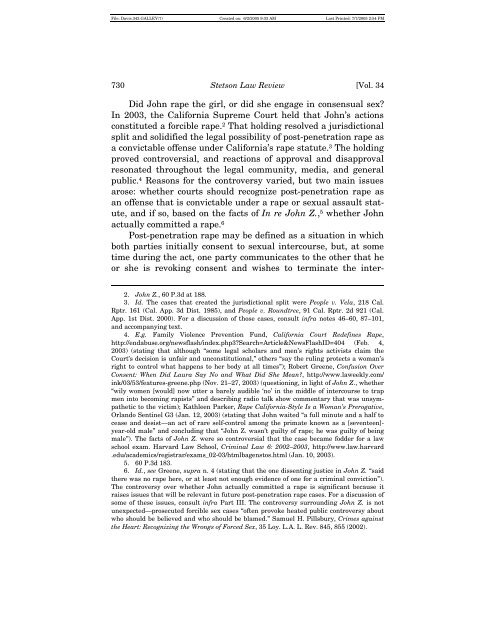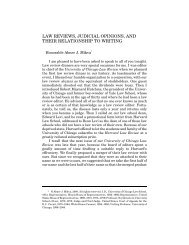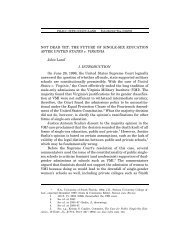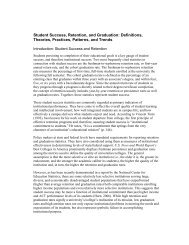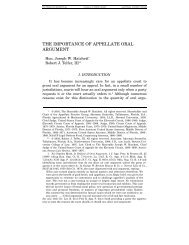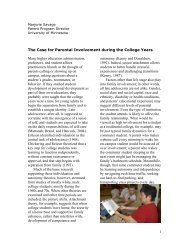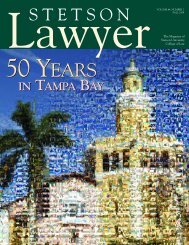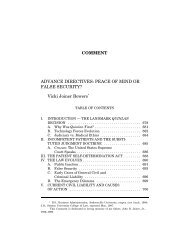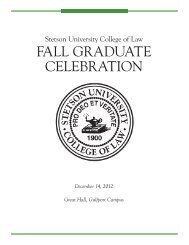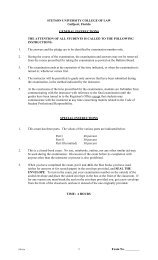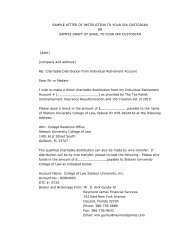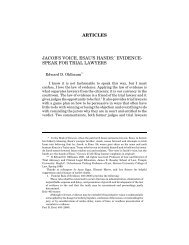the evolution of post-penetration rape law - Stetson University ...
the evolution of post-penetration rape law - Stetson University ...
the evolution of post-penetration rape law - Stetson University ...
You also want an ePaper? Increase the reach of your titles
YUMPU automatically turns print PDFs into web optimized ePapers that Google loves.
File: Davis.343.GALLEY(7) Created on: 6/2/2005 9:33 AM Last Printed: 7/7/2005 2:54 PM730 <strong>Stetson</strong> Law Review [Vol. 34Did John <strong>rape</strong> <strong>the</strong> girl, or did she engage in consensual sex?In 2003, <strong>the</strong> California Supreme Court held that John’s actionsconstituted a forcible <strong>rape</strong>. 2 That holding resolved a jurisdictionalsplit and solidified <strong>the</strong> legal possibility <strong>of</strong> <strong>post</strong>-<strong>penetration</strong> <strong>rape</strong> asa convictable <strong>of</strong>fense under California’s <strong>rape</strong> statute. 3 The holdingproved controversial, and reactions <strong>of</strong> approval and disapprovalresonated throughout <strong>the</strong> legal community, media, and generalpublic. 4 Reasons for <strong>the</strong> controversy varied, but two main issuesarose: whe<strong>the</strong>r courts should recognize <strong>post</strong>-<strong>penetration</strong> <strong>rape</strong> asan <strong>of</strong>fense that is convictable under a <strong>rape</strong> or sexual assault statute,and if so, based on <strong>the</strong> facts <strong>of</strong> In re John Z., 5 whe<strong>the</strong>r Johnactually committed a <strong>rape</strong>. 6Post-<strong>penetration</strong> <strong>rape</strong> may be defined as a situation in whichboth parties initially consent to sexual intercourse, but, at sometime during <strong>the</strong> act, one party communicates to <strong>the</strong> o<strong>the</strong>r that heor she is revoking consent and wishes to terminate <strong>the</strong> inter-2. John Z., 60 P.3d at 188.3. Id. The cases that created <strong>the</strong> jurisdictional split were People v. Vela, 218 Cal.Rptr. 161 (Cal. App. 3d Dist. 1985), and People v. Roundtree, 91 Cal. Rptr. 2d 921 (Cal.App. 1st Dist. 2000). For a discussion <strong>of</strong> those cases, consult infra notes 46–60, 87–101,and accompanying text.4. E.g. Family Violence Prevention Fund, California Court Redefines Rape,http://endabuse.org/newsflash/index.php3?Search=Article&NewsFlashID=404 (Feb. 4,2003) (stating that although “some legal scholars and men’s rights activists claim <strong>the</strong>Court’s decision is unfair and unconstitutional,” o<strong>the</strong>rs “say <strong>the</strong> ruling protects a woman’sright to control what happens to her body at all times”); Robert Greene, Confusion OverConsent: When Did Laura Say No and What Did She Mean?, http://www.<strong>law</strong>eekly.com/ink/03/53/features-greene.php (Nov. 21–27, 2003) (questioning, in light <strong>of</strong> John Z., whe<strong>the</strong>r“wily women [would] now utter a barely audible ‘no’ in <strong>the</strong> middle <strong>of</strong> intercourse to trapmen into becoming rapists” and describing radio talk show commentary that was unsympa<strong>the</strong>ticto <strong>the</strong> victim); Kathleen Parker, Rape California-Style Is a Woman’s Prerogative,Orlando Sentinel G3 (Jan. 12, 2003) (stating that John waited “a full minute and a half tocease and desist—an act <strong>of</strong> rare self-control among <strong>the</strong> primate known as a [seventeen]-year-old male” and concluding that “John Z. wasn’t guilty <strong>of</strong> <strong>rape</strong>; he was guilty <strong>of</strong> beingmale”). The facts <strong>of</strong> John Z. were so controversial that <strong>the</strong> case became fodder for a <strong>law</strong>school exam. Harvard Law School, Criminal Law 6: 2002–2003, http://www.<strong>law</strong>.harvard.edu/academics/registrar/exams_02-03/htmlbagenstos.html (Jan. 10, 2003).5. 60 P.3d 183.6. Id., see Greene, supra n. 4 (stating that <strong>the</strong> one dissenting justice in John Z. “said<strong>the</strong>re was no <strong>rape</strong> here, or at least not enough evidence <strong>of</strong> one for a criminal conviction”).The controversy over whe<strong>the</strong>r John actually committed a <strong>rape</strong> is significant because itraises issues that will be relevant in future <strong>post</strong>-<strong>penetration</strong> <strong>rape</strong> cases. For a discussion <strong>of</strong>some <strong>of</strong> <strong>the</strong>se issues, consult infra Part III. The controversy surrounding John Z. is notunexpected—prosecuted forcible sex cases “<strong>of</strong>ten provoke heated public controversy aboutwho should be believed and who should be blamed.” Samuel H. Pillsbury, Crimes against<strong>the</strong> Heart: Recognizing <strong>the</strong> Wrongs <strong>of</strong> Forced Sex, 35 Loy. L.A. L. Rev. 845, 855 (2002).


